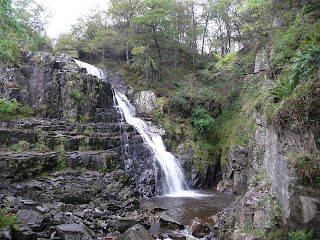I posted the Caerdeon blog at the beginning of October, so now 'all' I have to do to bring this blog up-to-date is write about the three months since the end of July! it seems an impossible task, so I plan to concentrate on the subsequent three meetings of Merioneth Nats/Group Natur Meirionnydd.
 |
Most of "the team" at Post Croesor
|
In August we had probably the best field trip of the year for Merioneth Nats, when we met at Pont Croesor to walk north through wet meadows, and even wetter woods, on the east bank of the Afon Glaslyn as it approaches the sea. It was the best attendance of the year, too, and we were rewarded with a good haul of records, as it appears that the tetrad has never before been recorded at that resolution. Even the hectad seems to be under-recorded, as only 49 of the 159 records for that square had been recorded before!
 |
| That branch was rotten! Photo: Andrew Graham |
There were rather a lot of aliens including
American Skunk-cabbage,
Lysochiton americanus and rather a lot of I
mpatiens glandiflora, Himalayan Balsam which we enjoyed uprooting, although probably too late to prevent most of the plants from seeding! Our best records were both aquatics,
Schoenoplectus tabernaemontii, Grey Club-rush, rather further from the sea than it is usually found, and an honorary vascular plant,
Nitella flexilis, Smooth Stonewort.
 |
| Cnicht, the Welsh Matterhorn |
We then retraced our steps to record in the tetrad to the south particularly hoping to re-find the
Carum verticillatum, Whorled Caraway, recorded from there previously. We found it in abundance, together with a number of other nice species in the pools just south of the tetrad line and as we reached the road again a number of weedy species alongside.
 |
| The way home - Cnicht and the Moelwyns from Pont Croesor |



























